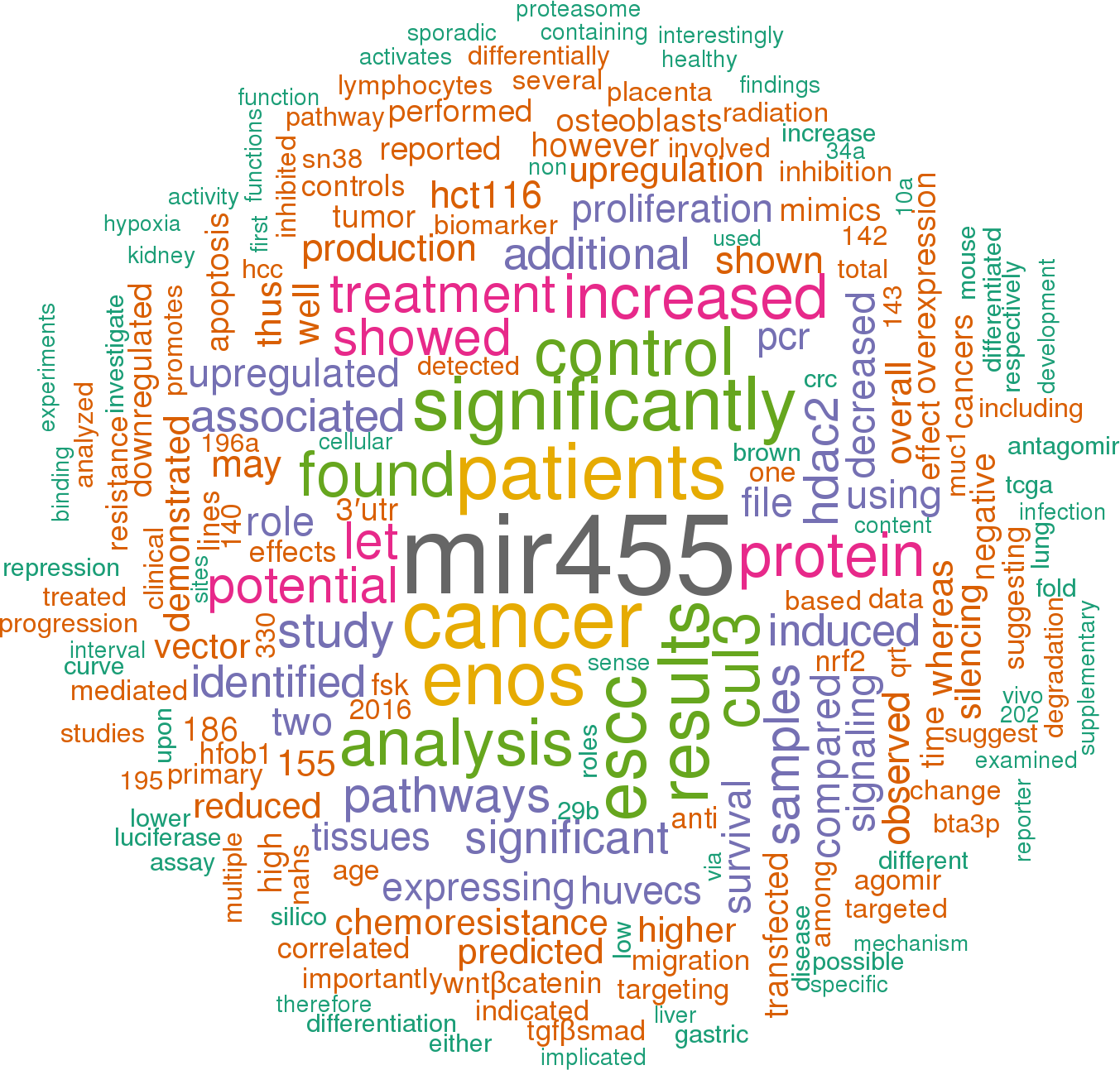Accession
MI0003513
Symbol
HGNC:
MIR455
Description
Homo sapiens
hsa-mir-455 precursor miRNA
Gene family
MIPF0000129;
mir-455
Summary
Caution, this is an AI generated summary based on literature. This may have errors. ?
MIR455 is a microRNA that is implicated in various diseases and conditions. It is specifically linked with hepatocellular carcinoma (HCC), gastric cancer (GC), and colorectal cancer (CRC) [PMC8369952]. In addition, MIR455 is associated with endometrial cancers [PMC8369952]. It has been found that certain microRNAs, including MIR455, regulate brown adipocyte differentiation [PMC7123371]. In multiple myeloma patients, high expression of MIR455 is considered a favorable prognostic factor [PMC6183594]. Furthermore, irregular expression of MIR455 has been observed in patients with preeclampsia, suggesting its potential role in the pathogenesis of the condition [PMC4540200]. Interestingly, MIR455 has also been detected in the exosomal population after exercise in type 2 diabetic mice, indicating that its content varies depending on the cells of origin at the time of secretion [PMC4568920]. MIR455 and Mir511 are largely expressed in the alimentary system and are involved in response to stimulus processes [PMC8369952]. In terms of cardiovascular health, MIR455 has been found to be cardioprotective in type 1 diabetes mellitus (T1DM) while Mir22 plays a similar role in type 2 diabetes mellitus (T2DM) [PMC7593653]. The formation of MIR455 is induced by cold temperature exposure and BMP7. This induction is necessary for the development of both brown adipose tissue (BAT) and recruitable beige adipose tissue (BeAT) [PMC7123371]. To verify predicted targets for MIR455 and to test its functionality within miRNA-induced silencing complex (miRISC), a dual luciferase-based miRNA-activity reporter assay was adopted. This assay involved renilla luciferase (RL) and firefly luciferase (FL) reporter genes [PMC4540200]. The observed elevation in mature MIR455 in BeWo cells upon FSK treatment can be attributed to increased expression of the COL27A1 gene [PMC4540200].
Literature search

75 open access papers mention hsa-mir-455
(620 sentences)
(620 sentences)
Sequence
49975
reads,
927
reads per million, 127 experiments
ucccuggcgugagggUAUGUGCCUUUGGACUACAUCGuggaagccagcaccauGCAGUCCAUGGGCAUAUACACuugccucaaggccuaugucauc
.....(((.(((((((((((((((.((((((.(((.(((........))).))).)))))).)))))))))).....)))))..))).........
.....(((.(((((((((((((((.((((((.(((.(((........))).))).)))))).)))))))))).....)))))..))).........
Structure
----ucccu -g ----- U A C gaa
ggc ugagg gUAUGUGCCU UGGACU CAU Gug g
||| ||||| |||||||||| |||||| ||| |||
ccg acucc CAUAUACGGG ACCUGA Gua cac c
cuacuguau ga guuCA U C c gac
Annotation confidence
Not enough data
Do you think this miRNA is real?
Comments
The mir-455 precursor was predicted computationally and a 5' mature product verified in human by Northern blot [1]. The precise sequence termini of the mature forms were derived by cloning from human and rat samples [2].
Genome context
chr9: 114209434-114209529 [+]
Disease association
hsa-mir-455 is associated with one or more human diseases in the Human microRNA Disease Database
| Disease | Description | Category | PubMed ID |
|---|
Mature hsa-miR-455-5p
| Accession | MIMAT0003150 |
| Description | Homo sapiens hsa-miR-455-5p mature miRNA |
| Sequence | 16 - UAUGUGCCUUUGGACUACAUCG - 37 |
| Evidence |
experimental
Northern [1], cloned [2-3] |
| Database links |



|
| Predicted targets |



|
Mature hsa-miR-455-3p
| Accession | MIMAT0004784 |
| Description | Homo sapiens hsa-miR-455-3p mature miRNA |
| Sequence | 54 - GCAGUCCAUGGGCAUAUACAC - 74 |
| Evidence |
experimental
cloned [2-3] |
| Database links |



|
| Predicted targets |



|
References
|



